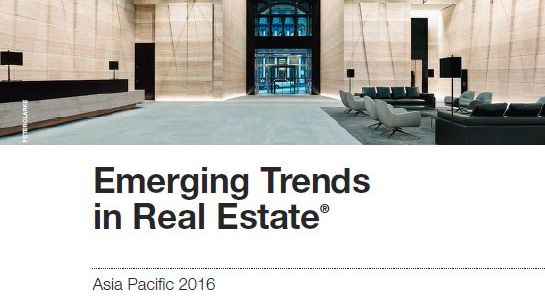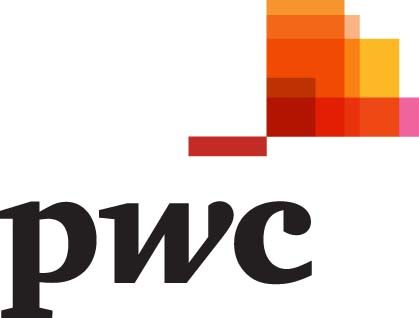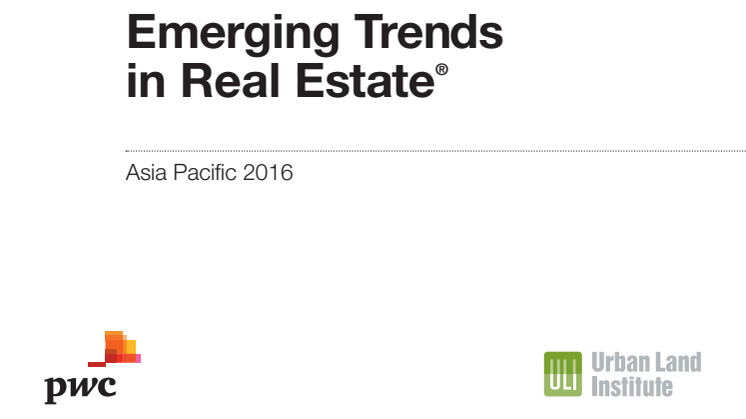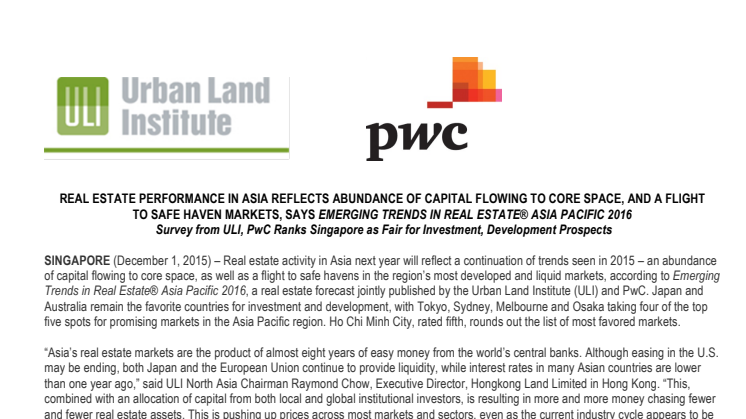
Press release -
Real estate performance in Asia reflects abundance of capital flowing to core space, and a flight to safe haven markets, says Emerging Trends in Real Estate® Asia Pacific 2016
SINGAPORE (December 1, 2015) – Real estate activity in Asia next year will reflect a continuation of trends seen in 2015 – an abundance of capital flowing to core space, as well as a flight to safe havens in the region’s most developed and liquid markets, according to Emerging Trends in Real Estate® Asia Pacific 2016, a real estate forecast jointly published by the Urban Land Institute (ULI) and PwC. Japan and Australia remain the favorite countries for investment and development, with Tokyo, Sydney, Melbourne and Osaka taking four of the top five spots for promising markets in the Asia Pacific region. Ho Chi Minh City, rated fifth, rounds out the list of most favored markets.
“Asia’s real estate markets are the product of almost eight years of easy money from the world’s central banks. Although easing in the U.S. may be ending, both Japan and the European Union continue to provide liquidity, while interest rates in many Asian countries are lower than one year ago,” said ULI North Asia Chairman Raymond Chow, Executive Director, Hongkong Land Limited in Hong Kong. “This, combined with an allocation of capital from both local and global institutional investors, is resulting in more and more money chasing fewer and fewer real estate assets. This is pushing up prices across most markets and sectors, even as the current industry cycle appears to be winding down. We can expect this to continue throughout 2016, with the most attention being paid to the markets perceived as offering certainty in terms of low risk and satisfactory returns.”
“Given the current sentiments of Singapore’s property market, we’re seeing local players becoming more involved at a regional and global level as they explore, increase and diversify investments into other major markets such as Japan and Australia,” said Yeow Chee Keong, Real Estate & Hospitality Leader, PwC Singapore. “In regards to the local market, there will still be acquisition opportunities in the commercial space over the next 12 months. Singapore will always be an attractive city state to invest in as mirrored in the Building Better Cities report, launched at the recent APEC CEO Summit, where Singapore secured the third position among 28 APEC cities for its excellence in culture & social health, connectivity, environmental sustainability and economics. The residential market will continue to hope for an increase in the level of transactions, and that will be dependent on whether there will be modifications made to the cooling measures.”
Emerging Trends, released today during ULI Singapore’s 2015 Annual Meeting, provides an outlook on Asia Pacific real estate investment and development trends, real estate finance and capital markets, and trends by property sector and metropolitan area. It is based on the opinions of 343 internationally renowned real estate professionals, including investors, developers, property company representatives, lenders, brokers and consultants.
Survey respondents ranked Singapore eleventh for investment prospects and ninth for development, placing the city in the middle of the list of the 22 markets covered by the report. It attributes Singapore’s rating to the market’s loss of traction in 2015 following a surge in commercial rents in 2014. The report notes that businesses in the city are having problems expanding due to a tight labor market and ongoing restrictions on hiring foreign staff. In addition, it points to a slow residential market, mainly due to government actions in 2013 to stem soaring home prices. Still, despite the tepid enthusiasm, “Singapore is always a market where institutions are looking to buy,” says Emerging Trends, adding that a number of major property purchases are expected to be completed before the end of 2015.
The top five markets for investment and development in 2016:
- Tokyo (ranked first for investment and development) – Tokyo “ticks all the boxes” for investors given its status as Asia’s top gateway city, and the market with the greatest depth and liquidity. Still, despite the continuous heavy activity fueled by easy credit and low interest rates, some are wary that the market is slowing. While the short-term outlook is favorable, a slowdown, accompanied by price stagnation or declines, could prove problematic for those needing to refinance high loan-to-value loans in the future, the report cautions.
- Sydney (second for investment and development) – Sydney is a draw for institutional investors seeking core office properties. The shortage of those assets and an influx of new investors competing for the properties, coupled with a depreciated local currency, is resulting in strong property yields. Real estate in Sydney is also benefiting from the transformation of Australia’s economy from a commodities-driven to a service sector-driven model. In addition, a significant number of office-to-residential conversions and redevelopment projects have drawn investor interest.
- Melbourne (third for investment and development) – Melbourne is perceived as offering a similar environment to Sydney. However, even with double-digit price increases in 2015, properties in the city remain more affordable than those in Sydney, mainly because more land is available for an expansion of the central business district (CBD). Absorption remains strong, both from newly arrived businesses and those moving from the suburbs to the core of the city.
- Osaka (fourth for investment, fifth for development) – Osaka continues to benefit Tokyo’s “spillover demand,” as investors migrate to the smaller city where competition is not as stiff. Yields for residential properties are particularly strong, although commercial assets are also performing well. The market’s impressive growth “marks the end of a long period of oversupply that plagued the city for years,” notes the report.
- Ho Chi Minh City (fifth for investment, fourth for development) – Ho Chi Minh City’s rating has soared over the past two years, jumping from 19th place in 2014 to one of the top five for 2016.The report attributes its surge in popularity to successful efforts by the government to stabilize the local currency and keep inflation in check, coupled with a revival of real estate lending by banks. In addition, improved market access for foreigners is drawing outside investors, who could significantly boost purchases of both residential and commercial properties.
Across the Asia-Pacific region, the industrial/logistics sector continues to be the most popular property type for investment prospects. “Shortages of modern distribution facilities across almost all markets ensures that demand will continue to grow, especially in China,” says the report. It notes that demand is being driven by the need for rapid delivery resulting from the e-commerce boom, buildout in the cold-food chain, and structural changes in regional manufacturing as operations move to emerging markets such as Vietnam.
Overall findings from the report include the following:
• Weaker land sales in the first half of the year was attributed mainly to slower sales in China. While some international investors remain cautious about the mainland, transactions across the region picked up strongly in the second half and are now expected to match or exceed last year’s record levels.
• Yields are now also pushing record heights in most markets, but buying momentum seems unlikely to slow in 2016. As a result, although a few investors see current pricing as a high-water mark, the majority believe the growing weight of capital will continue to push prices up and yields down, albeit at a slowing pace. Meanwhile, investors increasingly are opting to take profits, exiting deals made in the years after the global financial crisis.
• With yields in Asia now at levels often deemed uncompetitive compared with deals on offer in the United States and Europe, some investors continue to move up the risk curve, investing in asset classes and geographies that provide better returns. At the same time, this trend has probably slowed since last year. Investors with an eye on a possible peak in the cycle are more likely to gravitate toward the safety of core assets in gateway cities.
• Although yields may have further to run in markets such as Australia and Japan, many investors now see rental growth (rather than cap-rate compression) as a source of future profits. This is a controversial notion, however. While the cycles in both countries are at a point where rent increases are plausible, other investors see such expectations as rationalizations.
• Opportunistic returns are tough to find in the current environment, but plenty of funds operate—apparently profitably—in the space. The best venues for opportunistic returns currently are Japan (where cheap debt and high leverage provide scope to financially engineer outsized profits) and China (where developers are strapped for cash, liquidity is in short supply, and the slowing economy is scaring away other potential sources of capital). Opportunities for distress, meanwhile, remain elusive, with the possible exceptions of China and India.
• Emerging markets such as the Philippines, Vietnam, and Indonesia have enduring appeal given the higher yields and growth they offer. But most investors are steering clear in practice given the heightened levels of risk in the current environment, with high exchange rate and capital flow volatility as the United States heads toward an impending hike in the base rate. • More institutional investors are crowding into Asian markets. A proliferation of mergers and acquisitions and portfolio-type deals are resulting from the search for ways to invest large sums of capital from institutions.
• There is plenty of risk out there. However, the most commonly mentioned scenarios involved faster-than-expected increases in interest rates, and—a perennial favorite—a hard landing in China with a knock-on effect across the rest of Asia.
About the Urban Land Institute
The Urban Land Institute (www.uli.org) is a nonprofit education and research institute supported by its members. Its mission is to provide leadership in the responsible use of land and in creating and sustaining thriving communities worldwide. Established in 1936, the Institute has nearly 35,000 members worldwide representing all aspects of land use and development disciplines, including more than 1,850 in Asia.
About PwC
PwC helps organisations and individuals create the value they’re looking for. We’re a network of firms in 157 countries with more than 208,000 people who are committed to delivering quality in assurance, tax and advisory services. Find out more and tell us what matters to you by visiting us at www.pwc.com.
© 2015 PwC. All rights reserved
PwC refers to the PwC network and/or one or more of its member firms, each of which is a separate legal entity. Please see www.pwc.com/structure for further details.
Media Contacts
ULI
Cheryl Pan
BlueCurrent Group
Tel: +852 2586 7887
cheryl.pan@bluecurrentgroup.com
PwC
Natalie Choo
Media Liaison
Tel: +65 9738 1415
natalie.yl.choo@sg.pwc.com
Related links
Topics
Categories
About PwC
At PwC, our purpose is to build trust in society and solve important problems. We’re a network of firms in 157 countries with more than 208,000 people who are committed to delivering quality in assurance, advisory and tax services. Find out more and tell us what matters to you by visiting us at www.pwc.com.
PwC refers to the PwC network and/or one or more of its member firms, each of which is a separate legal entity. Please see www.pwc.com/structure for further details.
©2015 PwC. All rights reserved




